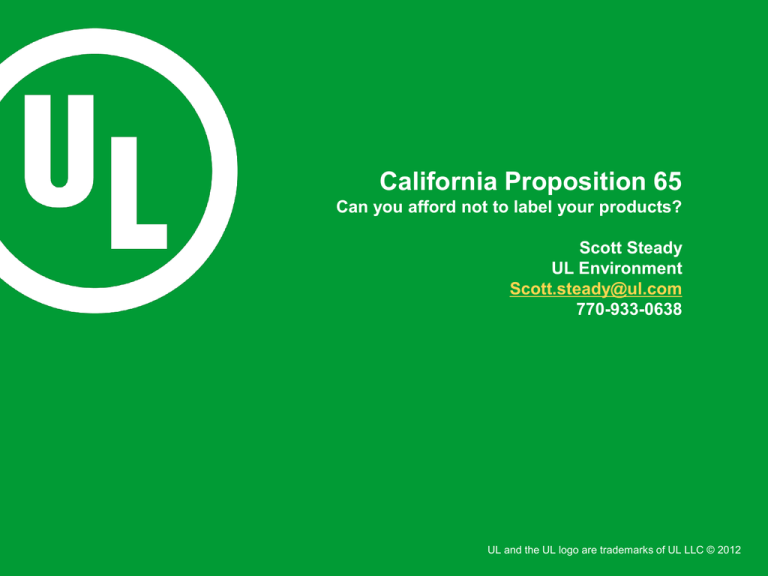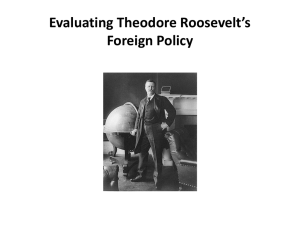Scott Steady Presentation - Chemical Fabrics and Film Association
advertisement

California Proposition 65 Can you afford not to label your products? Scott Steady UL Environment Scott.steady@ul.com 770-933-0638 UL and the UL logo are trademarks of UL LLC © 2012 What is Proposition 65? Proposition 65, the Safe Drinking Water and Toxic Enforcement Act of 1986, was enacted as a ballot initiative in November 1986. Proposition 65 required the Governor of California to publish a list of chemicals that are “known to the State of California” to cause cancer, birth defects or other reproductive harm. The list is updated quarterly by the California’s Office of Environmental Health Hazard Assessment (OEHHA) - (http://www.oehha.ca.gov/prop65.html) - there are ~900 chemicals on the list Before knowing and intentional exposure of a person in CA to listed chemicals, a business must provide “clear and reasonable warning”. THIS PRESENTATION IS FOR GENERAL INFORMATION PURPOSES ONLY AND IS NOT INTENDED TO CONVEY LEGAL OR OTHER PROFESSIONAL ADVICE. 2 THIS PRESENTATION IS FOR GENERAL INFORMATION PURPOSES ONLY AND IS NOT INTENDED TO CONVEY LEGAL OR OTHER PROFESSIONAL ADVICE. 3 Enforcement by Litigation Enforcement is carried out through civil lawsuits brought by the California Attorney General, or by a district attorney or city attorney Primary enforcement is by private plaintiff’s attorneys (~95% of cases)* - Send written notice to public prosecutors and violator - Wait 60 days to make sure no public prosecutor sues Nearly 20,000 notices have been served since 1986* In the past 5 years, settlements have totaled about $75,000,000* - Almost 90% of the settlement money goes to plaintiffs attorney - Settlements typically require product reformulation and/or labeling * Statistics compiled from http://oag.ca.gov/prop65 THIS PRESENTATION IS FOR GENERAL INFORMATION PURPOSES ONLY AND IS NOT INTENDED TO CONVEY LEGAL OR OTHER PROFESSIONAL ADVICE. 4 The Burden of Proof The plaintiff only has to show “detectable exposure” to a listed chemical and then the burden of proof is on the defendant. Defendant must demonstrate that the level of exposure is not significant. Businesses that cause exposures greater than the safe harbor level must provide Proposition 65 warnings. OEHHA provides safe harbor levels for some listed chemicals. It is the manufacturers responsibility to develop a safe harbor level if none exists. THIS PRESENTATION IS FOR GENERAL INFORMATION PURPOSES ONLY AND IS NOT INTENDED TO CONVEY LEGAL OR OTHER PROFESSIONAL ADVICE. 5 How do you know if your products need a warning label? Proposition 65 applies only to exposures to listed chemicals. It does not ban or restrict the use of any given chemical. Use your knowledge of the materials and chemicals used in your products. Review the Proposition 65 list to determine if there are any listed chemicals for which your products may be a source of exposure. (http://oehha.ca.gov/prop65/getNSRLs.html) Depending on the level of exposure, you may be required to provide a warning. THIS PRESENTATION IS FOR GENERAL INFORMATION PURPOSES ONLY AND IS NOT INTENDED TO CONVEY LEGAL OR OTHER PROFESSIONAL ADVICE. 6 Contact your Attorney! If a notice is received, the client should contact their legal team. It is recommended to seek advice from lawyers who specialize in CA Prop 65. Even if you are proactively investigating risk for your products with respect to Proposition 65, it may be best to conduct the work under the direction of an attorney. THIS PRESENTATION IS FOR GENERAL INFORMATION PURPOSES ONLY AND IS NOT INTENDED TO CONVEY LEGAL OR OTHER PROFESSIONAL ADVICE. 7 Essential Skills for Making a Proposition 65 Determination Legal Expertise Determining anticipated levels of exposure to listed chemicals can be very complex. Because a business has the burden of proving a warning is not required, you should consider consulting a qualified professional. (from OEHHA website FAQs) Toxicology THIS PRESENTATION IS FOR GENERAL INFORMATION PURPOSES ONLY AND IS NOT INTENDED TO CONVEY LEGAL OR OTHER PROFESSIONAL ADVICE. Chemical Analysis 8 Elements of a Proposition 65 Evaluation 1. Determine the potential listed chemicals that may be associated with your product. 2. Conduct testing to measure the level of listed chemical in your product or emitted from your product (leaching or offgassing). 3. Use the data to perform an exposure assessment using conservative assumptions. 4. Develop a safe harbor level if one doesn’t exist, and compare the exposure level to the safe harbor level. THIS PRESENTATION IS FOR GENERAL INFORMATION PURPOSES ONLY AND IS NOT INTENDED TO CONVEY LEGAL OR OTHER PROFESSIONAL ADVICE. 9 Determining Chemicals of Concern Review MSDS Sheets from all suppliers (and their suppliers when possible) Require supplier disclosure of Prop 65 chemicals Identify settlement restrictions from past litigation • Halloween costumes (Lead, Cadmium, Formaldehyde, Phthalates) • Fashion Accessories (Lead) • Electrical Cords (Lead) THIS PRESENTATION IS FOR GENERAL INFORMATION PURPOSES ONLY AND IS NOT INTENDED TO CONVEY LEGAL OR OTHER PROFESSIONAL ADVICE. 10 Identify Potential Exposure Routes There are 3 primary routes of chemical exposure: • Ingestion (oral) – food, water, accidental • Skin absorption (dermal) – clothing or routinely handled objects • Inhalation – gases (VOCs) or particles All exposure routes may need to be considered depending on how your product is used. Different types of testing are recommended depending on the routes of exposure for your product. THIS PRESENTATION IS FOR GENERAL INFORMATION PURPOSES ONLY AND IS NOT INTENDED TO CONVEY LEGAL OR OTHER PROFESSIONAL ADVICE. 11 What tests need to be conducted? The regulations provide no guidance on what test methods should be used. “Determinations must be based on evidence and standards of comparable scientific validity to those that form the scientific basis for the listing of the chemical.” The test methods will depend on the chemicals suspected to be present and the anticipated exposure route. Chemical Content Testing Wipe Testing Environmental Chamber Testing THIS PRESENTATION IS FOR GENERAL INFORMATION PURPOSES ONLY AND IS NOT INTENDED TO CONVEY LEGAL OR OTHER PROFESSIONAL ADVICE. 12 Environmental Chamber Testing Air Purification and Conditioning Predicting Indoor Exposure Levels Environmental Chamber Testing Sample Preparation Analysis and Reporting THIS PRESENTATION IS FOR GENERAL INFORMATION PURPOSES ONLY AND IS NOT INTENDED TO CONVEY LEGAL OR OTHER PROFESSIONAL ADVICE. 13 Environmental Chamber Guides Clean air generation systems Monitoring and control systems Chamber performance Sample collection and analysis equipment • ISO 16000-9 - Determination of the emission of volatile organic compounds from building products • ASTM D 5116-06 – Standard Guide for Small-Scale Environmental Chamber Determinations of and furnishing — Emission test chamber method Organic Emissions from Indoor Materials/Products • ASTM D 6670-01 – Standard Practice for Full-Scale Chamber Determination of Volatile Organic Emissions from Indoor Materials/Products THIS PRESENTATION IS FOR GENERAL INFORMATION PURPOSES ONLY AND IS NOT INTENDED TO CONVEY LEGAL OR OTHER PROFESSIONAL ADVICE. 14 VOC Measurement ASTM D 6196 / ISO 16000 Part 6 Collect chamber air on Tenax Sorbent Media, thermally desorb chemicals and analyze by GC/MS Applicable to the following listed compounds 100-41-4 106-46-7 108-88-3 110-80-5 Benzene, ethyl Benzene, 1,4-dichloro Toluene (Methylbenzene) Ethanol, 2-ethoxy 111-15-9 Ethanol, 2-ethoxy-, acetate (Ethylene glycol monoethyl ether acetate) 123-91-1 127-18-4 149-57-5 71-43-2 79-01-6 872-50-4 91-20-3 96-18-4 100-40-3 1,4-Dioxane Ethene, 1,1,2,2-tetrachloro (Tetrachloroethylene) Hexanoic acid, 2-ethyl Benzene Ethene, 1,1,2-trichloro (Trichloroethylene) 2-Pyrrolidinone, 1-methyl Naphthalene Propane, 1,2,3-trichloro Cyclohexene, 4-vinyl (4-Ethenylcyclohexene) THIS PRESENTATION IS FOR GENERAL INFORMATION PURPOSES ONLY AND IS NOT INTENDED TO CONVEY LEGAL OR OTHER PROFESSIONAL ADVICE. 15 Aldehyde Measurement ASTM D 5197 / ISO 16000 Part 3 Collect chamber air on DNPH Cartridge, elute with acetonitrile and analyze by HPLC Applicable to formaldehyde and acetaldehyde Particle Measurement Applicable to titanium dioxide and other airborne particulate that may contain listed chemicals Captured on filters for further analysis THIS PRESENTATION IS FOR GENERAL INFORMATION PURPOSES ONLY AND IS NOT INTENDED TO CONVEY LEGAL OR OTHER PROFESSIONAL ADVICE. 16 Building Product and Furniture Test Methods THIS PRESENTATION IS FOR GENERAL INFORMATION PURPOSES ONLY AND IS NOT INTENDED TO CONVEY LEGAL OR OTHER PROFESSIONAL ADVICE. 17 Personal Exposure Studies Perform activity in large chamber Recreate “true consumer experience” Measure concentrations in the breathing zone and/or in the rest of the room THIS PRESENTATION IS FOR GENERAL INFORMATION PURPOSES ONLY AND IS NOT INTENDED TO CONVEY LEGAL OR OTHER PROFESSIONAL ADVICE. 18 Predicting Exposure Concentrations • Define the product use environment - Room Volume - Product loading (surface area, units) - Ventilation (air changes per hour) • Determine duration and frequency of exposure - Hours/day - Days/year - Product life (years) • Compare the total exposure to the Safe Harbor Level - Average daily lifetime exposure (over 70 years) for Carcinogens - Maximum daily exposure for Reproductive Toxins THIS PRESENTATION IS FOR GENERAL INFORMATION PURPOSES ONLY AND IS NOT INTENDED TO CONVEY LEGAL OR OTHER PROFESSIONAL ADVICE. 19 Safe Harbor Levels NSRL • Carcinogen Safe Harbor Levels are termed No Significant Risk Levels (NSRL). • They are based on the most sensitive study meeting certain requirements and calculations described in regulations for an exposure level that results in 1 excess cancer in an exposed human population of 100,000 over a 70-yr lifetime. MADL • Reproductive Toxin Safe Harbor Levels are termed Maximum Allowable Dose Level (MADL). • They are based on the most sensitive study meeting certain requirements at a level that is 1,000 fold below the no observable effect level (NOEL) of the study. THIS PRESENTATION IS FOR GENERAL INFORMATION PURPOSES ONLY AND IS NOT INTENDED TO CONVEY LEGAL OR OTHER PROFESSIONAL ADVICE. 20 Legal Review Even if your product is shown to be under the safe harbor levels for any chemicals of concern, manufacturers should consult their attorney regarding the decision to label or not label their products! THIS PRESENTATION IS FOR GENERAL INFORMATION PURPOSES ONLY AND IS NOT INTENDED TO CONVEY LEGAL OR OTHER PROFESSIONAL ADVICE. 21 Questions? For more information on UL Environment services related to Proposition 65, please contact us at ul.com/environment 888.485.4733 environment@ul.com 22








